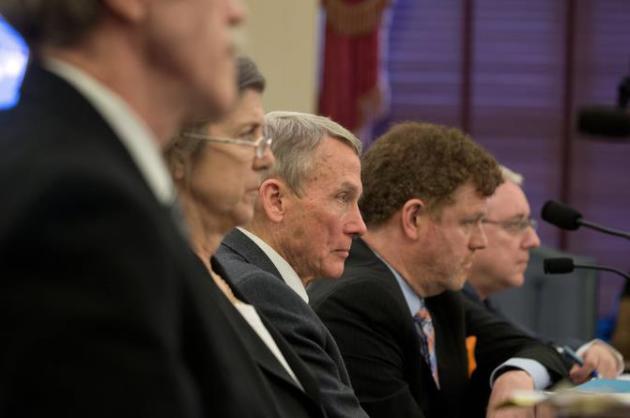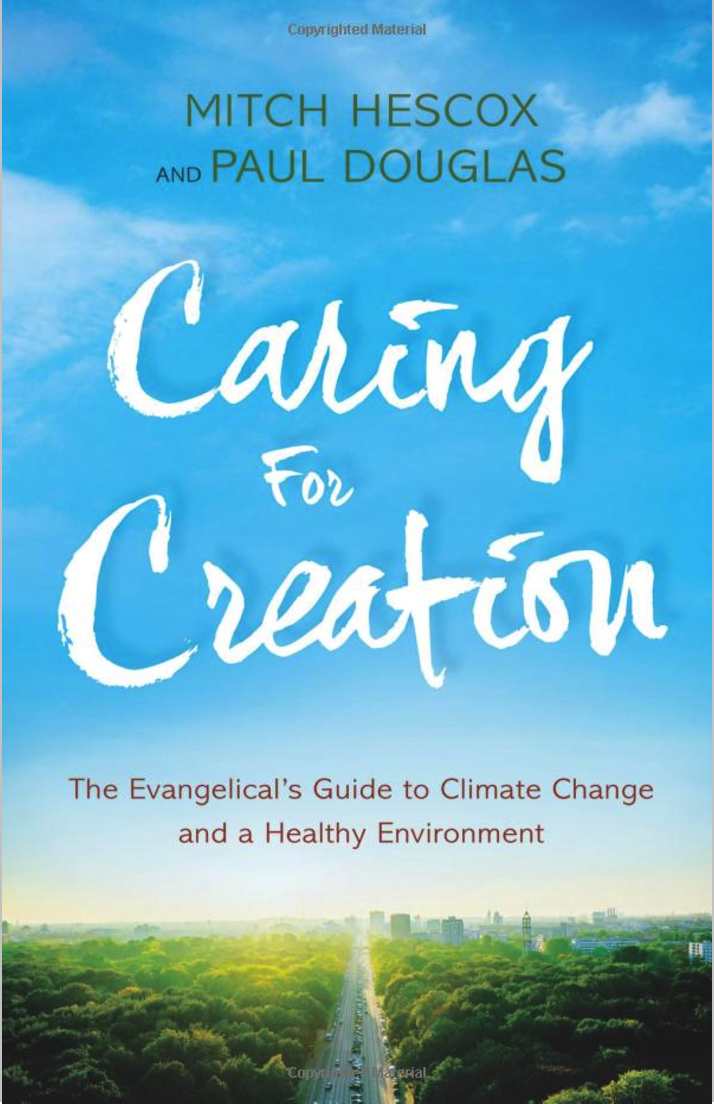The Weather Blog
Daily weather updates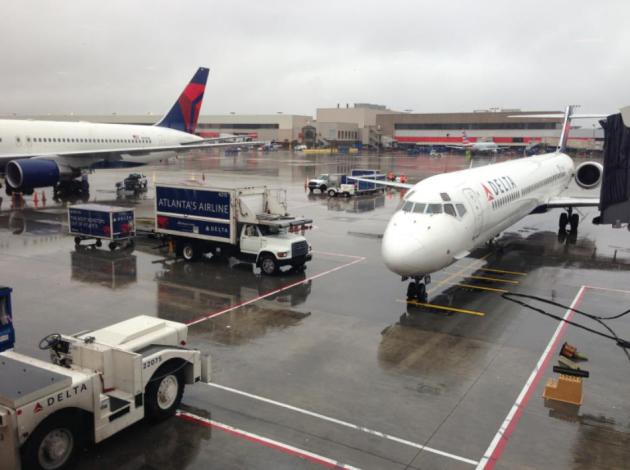
Windblown Showers Today – Cold Rain This Weekend – December Returns Next Week
46 F. high in the Twin Cities on Wednesday.
+11 F. temperatures during the first 9 days of December are 11 F. warmer than average at MSP.
29 F. average high on December 9.
23 F. high temperature on December 9, 2014.
December 10, 1992: By this time there is partial ice cover in the Duluth harbor.
December 10, 1979: A ‘heat wave’ develops across Minnesota. Highs of 54 at Twin Cities and 57 at Winona are recorded.
December 10, 1978: Alexandria ends its fourteen day stretch of low temperatures at or below zero degrees Fahrenheit.
December 10, 1889: A late season thunderstorm is observed at Maple Plain. Source: Twin Cities NWS.

Fear of Flying
Are Minnesotans Getting Soft?
I hate it when people clap after a successful landing. Do you clap when you pull into the garage and turn off the car? No. Flying back to MSP Tuesday we encountered springlike rain showers and some minor turbulence.
My wife took a “Fear of Flying” class at Northwest Airlines in the 90s. It helped her manage the inevitable bumps. The way I explained it to her: you don’t scream when your car hits a pothole, right?
Clear-air turbulence is an “atmospheric pothole”, created by eddies and whirlpools of fast-moving air. The only time I get nervous is when pilots (accidently) fly into T-storms.
“March-ember” lingers today with a shot at 50F; a growing chance of wind-whipped rain showers as a cooler front blows through town. A second surge of southern moisture arrives this weekend; the atmosphere just warm enough aloft for rain – maybe a light mix or ice for far northern Minnesota. Good grief. I fear we’re losing our winter weather mojo.
A coating of snow next Tuesday gives way to a few days in the 20s late next week. If you squint and pretend it might even look like December.

Temperatures Peak Near 50F Today. That’s about 20F warmer than average for he 10th day of December. Models are in tight alignment showing mid to upper 40s by midday. Source: Aeris Enterprise.
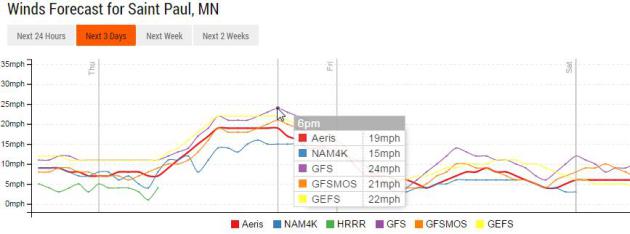
The Wind Machine Returns. Any time you have a significant shift in temperature the winds will blow. Sustained winds reach 20-25 mph later today with gusts as high as 35 mph.

Slush Up North? Some of the models are hinting at a little wet snow for the Brainerd Lakes area Friday evening into Saturday, maybe a quick inch or two, especially on lawns and fields. With temperatures near 32F many major roads will probably remain wet.
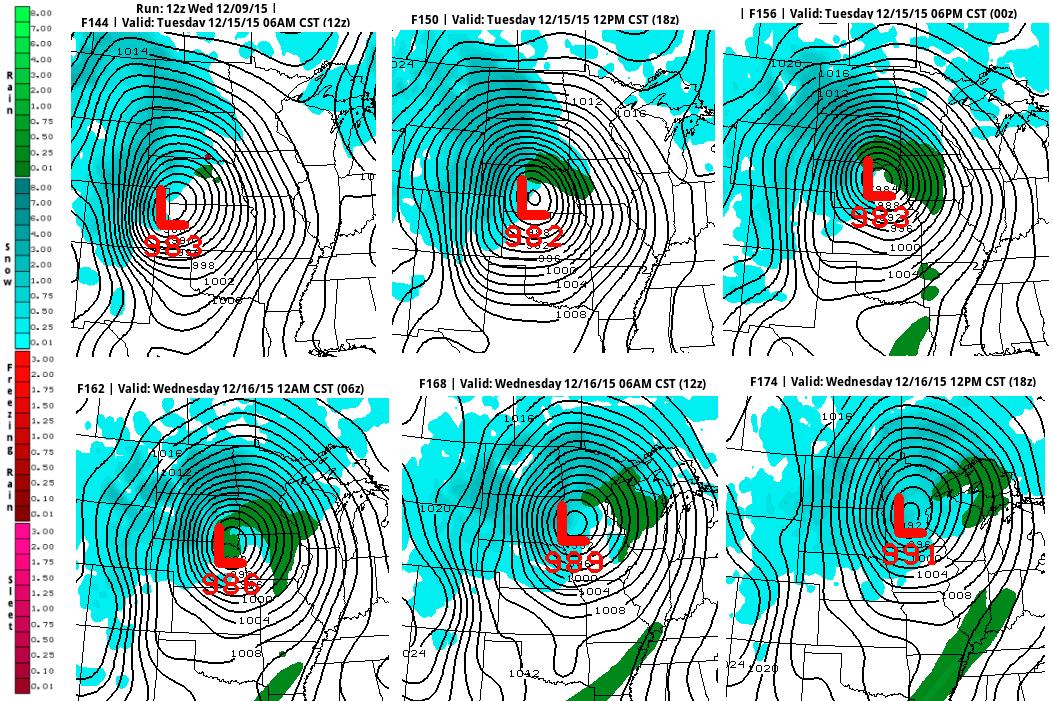
GFS Solution: Wild Wind Storm Next Wednesday? I’m not convinced this will verify, not yet. But NOAA’s GFS model shows a deep area of low pressure pushing across the Plains into the Upper Midwest Wednesday; the atmosphere warm enough for a rain/snow mix over southern and eastern Minnesota. Stay tuned.

Tumbling Into December. Enjoy today’s light jacket weather, because it may be time to dig out the coats again the latter half of next week, when highs may be in the 20s (above zero!) A cold rain is likely in and near the MSP metro over the weekend; the next system next Tuesday-Wednesday may be cold enough for slushy snow or a mix. Within a week there will be no doubt in your mind that it’s December.
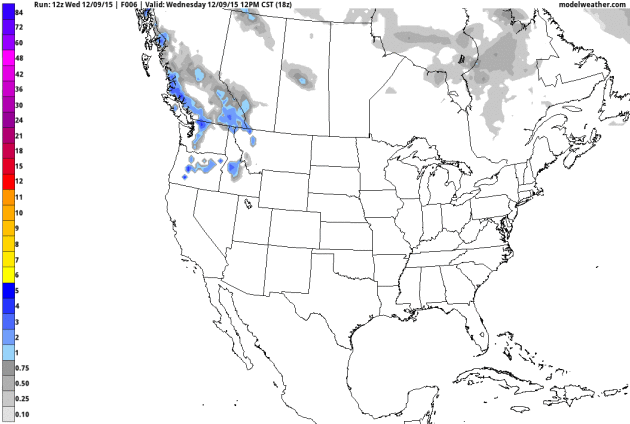
10-Day Snowfall Potential. GFS guidance shows a couple inches of slushy snow and ice up north this weekend; a better chance of a plowable snowfall over North Dakota and northern Minnesota by the middle of next week as colder air spins up a more significant storm. Animation: AerisWeather.
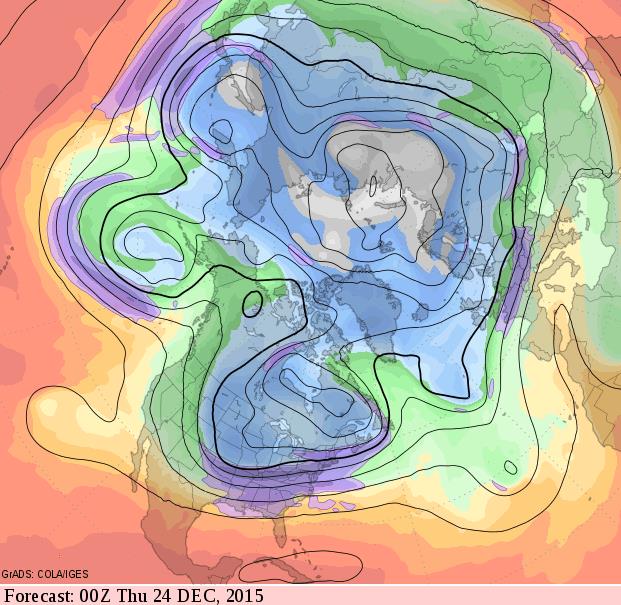
Chilly Christmas? Here’s the 500 mb forecast winds and jet stream configuration valid Wednesday evening, December 23, showing a deep closed low centered over Hudson Bay, Canada, a fresh supply of Canadian air pouring south into the USA. It will certainly be cold enough for a white Christmas; we’ll see if we can muster up a few “storms” for Santa’s big night.

January Preview: Ditto. When in doubt go with the flow. Meteorologists call this “persistence”. The same El Nino signal responsible for one of the mildest autumns (and Decembers, to date) on record will – in all probability – spill over into early 2016. NCEP CFSv2 climate guidance: NOAA and WeatherBell.
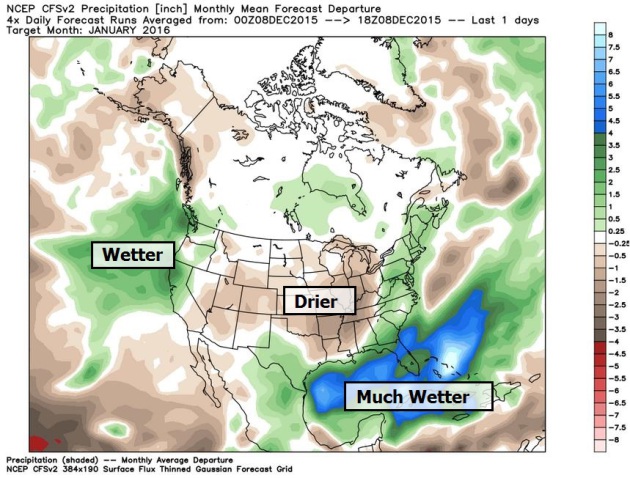
January Precipitation Anomaly Forecast. The El Nino signal persists; wet weather from the Pacific Northwest into northern California, much wetter for the Gulf Coast and Florida, while much of the Lower 48 experiences drier than average conditions.
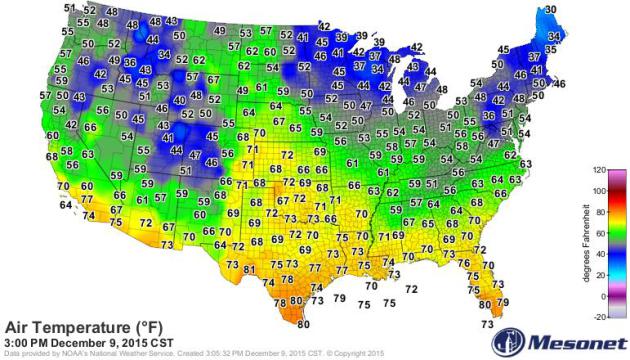
December Heat Wave? The Mercury’s About to Jump in Eastern U.S. Here’s a clip from Bloomberg: “…The U.S. Climate Prediction Center says the odds for above-normal temperatures in the East are 80 to 90 percent from Dec. 12 to 16. There’s an 80 percent chance the mild weather will continue through Dec. 20 in the Northeast. From Dec. 12 through Dec. 16, Commodity Weather Group LLC predicts readings will be 8 to 15 degrees above normal throughout the Northeast and eastern Canada. “It’s impressive,” said Matt Rogers, president of Commodity Weather in Bethesda, Maryland. Rogers said his prediction for the natural-gas weighted heating degree days value for December is about 725. The 30-year normal for the measurement of temperatures and heating demand is 872...”
3 PM Wednesday temperatures courtesy of Oklahoma Mesonet.
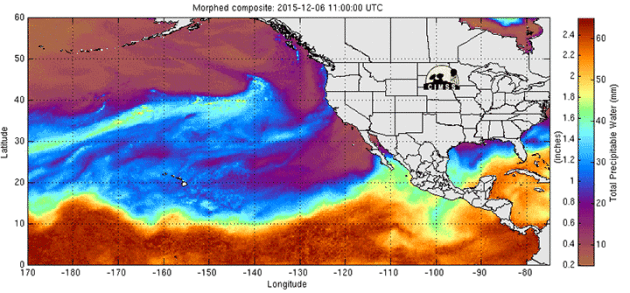
Mt. Rainier Faces Insane Amounts of Snow. So far the fire-hose of Pacific moisture has been aimed at the Pacific Northwest, not California. Here’s an excerpt from WXshift: “…Over the course of the week, Mount Rainier and other high peaks in the Pacific Northwest are slated to receive up to 15 feet of snow. To put that in perspective, here are some things that are roughly that tall:
- A ranch house
- The average male giraffe (h/t Chris Dolce)
- Shawn Kemp standing on Detlef Schrempf’s shoulders and holding his hands in the air
- The amount of snow Boston got last winter…plus 6 more feet
The Cascades are no stranger to staggering snowfalls. Mount Baker ski area holds the world record for snowiest winter on record. In 1998-99, 1,140 inches of snow fell on the mountain’s slopes. That’s 95 feet for those who don’t have a calculator handy. The previous record holder was also in the Northwest: Paradise Station, which is on the flanks of Mount Rainier, got 1,122 inches (93.5 feet) of snow in the winter of 1971-72...”
Animation credit: “An atmospheric river from the tropical Pacific is delivering heavy rain and snow to the Pacific Northwest and California this week.” Credit: CIMSS.

The Most Polluted City Is? Hint: Not Beijing. USA TODAY links to the list no city wants to be on; here’s the introduction: “As Beijing again makes worldwide news for its hideously smog-choked skies, a look at a list of some of the planet’s most polluted cities finds that the Chinese capital isn’t even in the top 20 for smog. While certainly wretched by American standards, Beijing’s average air pollution level is 53, on a scale from 26 to 208. (The numbers reflect the amount of the smog-causing microscopic particles in the air.) Many of the world’s most polluted cities are in India, with Delhi “leading” the pack with a level of 153. The report, which was prepared in 2014 by the World Health Organization, looked at outdoor air pollution in nearly 1,600 cities in 91 countries...”
File photo: “In this Nov. 25, 2015 photo, Sitesh Singh, 48, an auto rickshaw driver wears a mask to protect himself from pollution in New Delhi, India. Over the last decade the city’s air pollution has grown so rapidly that the cold weather turns the city into a grey, smog-filled health nightmare. New Delhi has earned the dubious distinction of being the world’s dirtiest city, surpassing Beijing, once the poster child for air pollution.” (AP Photo /Tsering Topgyal)

First-Ever Ibuprofen Patch Delivers Pain Relief Right Where It’s Needed. Interesting medical developments, highlighted at Gizmag: “One problem with orally-administered painkillers is that even though you may just have pain in a particular area, the medication affects your whole body. This both increases the chance of side effects, and limits the effect of the medication on that one area. Now, however, scientists at Britain’s University of Warwick have developed a solution – they’ve created the world’s first ibuprofen skin patch…”

It’s True – Being Handsome is a Living Hell. Not a problem that I have, thank goodness. Here’s an excerpt of a study recap at The Guardian: “…You knew all this – of course you did – but you probably weren’t aware of a new challenge to being a successful man. This bear-trap is the curse of handsomeness. According to a new study from University College London’s School of Management, men are more likely to be overlooked for competitive roles that rely upon individual talent – sales positions, for example – if they are perceived as handsome. Male superiors who fancy themselves as the alphas in your hedge fund, PPI call-centre or longbow showroom will pass you over for promotion, reluctant to place those they consider to be more handsome at the same level as themselves…”

Holiday Gift Guides:
Kottke.org has a wide range of gift ideas here.
The New York Times has an interesting selection for the serious traveler in your life.

TODAY: Few showers, gusty and unseasonably mild for mid-December. Winds: W 15-25. High: 48
THURSDAY NIGHT: Showers taper, still windy. Low: 32
FRIDAY: Mostly cloudy, still milder than average. Winds: E 8-13. High: 41
SATURDAY: Light rain and drizzle develops. Winds: E 10-15. Wake-up: 34. High: 39
SUNDAY: Rain tapers, drying PM hours. Winds: NW 10-15. Wake-up: 36. High: 39
MONDAY: More clouds than sun, quiet. Wake-up: 31. High: 37
TUESDAY: A little wet snow possible, especially north/west of MSP. Wake-up: 30. High: 35
WEDNESDAY: Flurries taper, colder wind kicks in. Feels like December. Wake-up: 26. High: 29
Climate Stories…
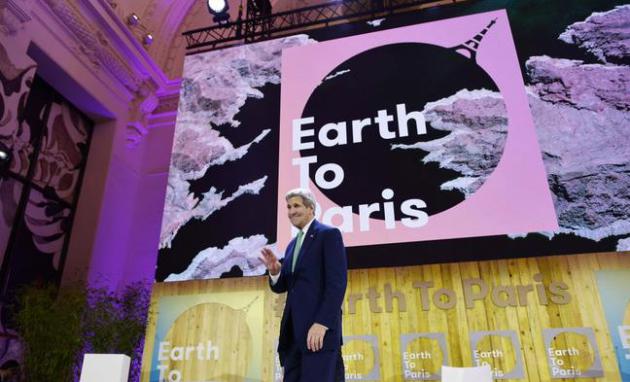
Climate Talks Show Signs of Progress. Here’s an excerpt of an update at The Wall Street Journal: “Strands of a deal on tackling climate change began to emerge Tuesday, but divisions remained on the two most contentious issues: Who will help developing countries pay for less-polluting energy generation and adapt to rising temperatures; and whether emerging economies take on larger responsibilities in the broader fight against global warming. Two days of negotiations among ministers managed to bridge some differences that had hamstrung the first week of talks here...”
Photo credit: “US Secretary of State John Kerry waves as he walks off stage after speaking at the Mashable/UN Foundation “Earth to Paris” summit at Le Petit Palais in Paris, France, on the sidelines of the COP21, the UN climate change conference, Monday, Dec. 7, 2015.” (Mandel Ngan/Pool Photo via AP)

How The U.S. Became an Unlikely Hero at the Paris Climate Summit. TIME reports; here’s the intro: “The U.S. has been an obstacle at past climate-change summits, but in Paris, it has been key to a deal Negotiators from the U.S. arrived in Paris last week for talks on climate change with a mandate from President Barack Obama to advance a strong deal to stem greenhouse-gas emissions. And with just days remaining before the conference is set to conclude, climate-policy experts say the U.S. has done just that…”

U.S. Proposes Raising Spending on Climate-Change Adaptation. No matter what we do to reduce emissions some level of adaptation will be required; it’s not optional at this point with additional warming already in the pipeline. Here’s an excerpt from an article at The New York Times: “In an effort to help smooth the passage of a sweeping new climate accord here this week, Secretary of State John Kerry announced on Wednesday a proposal to double its grant-based public finance for climate-change adaptation by 2020 to $860 million, from $430 million. Mr. Kerry’s announcement came as the momentum toward a deal appeared to have hit a momentary snag. Laurent Fabius, the French foreign minister who is presiding over the talks, delayed by two hours a self-imposed 1 p.m. deadline to release a new draft of the international agreement that negotiators here have been haggling over for more than a week…”
Photo credit above: “Secretary of State John Kerry delivered a speech during the United Nations conference on climate change at Le Bourget, just outside Paris, on Wednesday.” Credit Pool photo by Mandel Ngan.
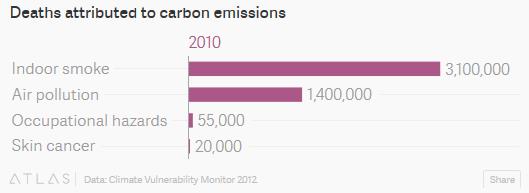
Fossil Fuels Kill More People Every Year than Wars, Murders and Traffic Accidents Combined. Yes, fossil fuels brought us to this point in time and made exponential gains in GDP and prosperity possible. But the way we’re keeping the lights on the economy powered up (today) is not sustainable. Here’s an excerpt at Quartz: “…One way out may be to reframe the debate. Global warming will affect billions of lives in the future. But, by one estimate, our love for fossil fuels may already be responsible for more deaths than those caused by wars, murders, and traffic accidents combined. These figures come from the 2012 Climate Vulnerability Monitor. In 2010, some 4.5 million deaths could be attributed to air pollution, because of the production of carbon particles and nitrogen oxides…”

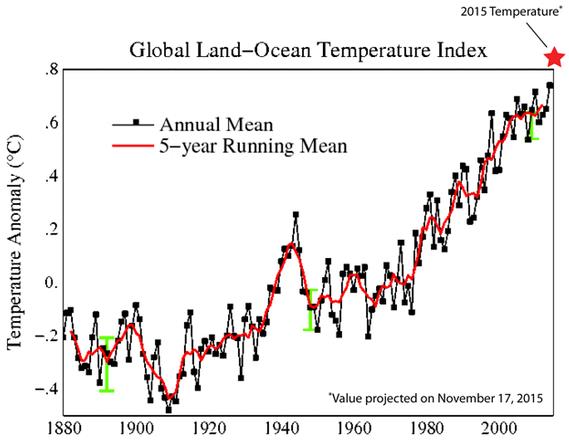
We Finally Have Hope on Climate Change. Here’s an excerpt of an Op-Ed at the Huffington Post from St. Thomas climate scientist John Abraham: “…Well, a few things have transpired in the past few years to show that real progress is possible. First of all, and perhaps most significant, is that the United States has moved from laggard to leader in international climate negotiations. Under the prior president, we would be blocking, halting, and dismissing any meaningful action on climate. Now we are initiating the actions. As a result, there are major agreements with our international partners, particularly China that bend the curve of our emissions downward. Next, the USA has done much domestically, such as formulated and instituted rules on coal-based electricity, increased fuel efficiency, reductions of other greenhouse gases, increased renewable energy production, killed the dumb-from-the-beginning Keystone pipeline, to name a few…”
Graphic credit: NASA.
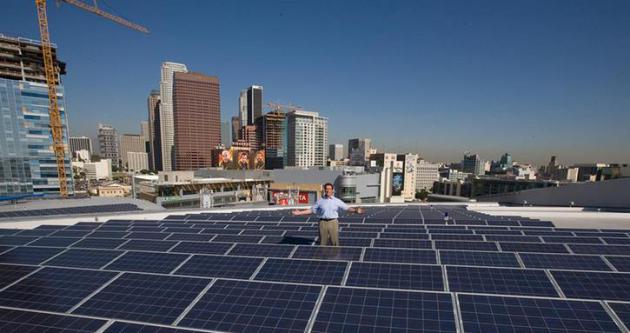
Arnold Schwarzenegger Doesn’t Give a (Flip) If You Agree With Him About Climate Change. Mashable has the details; here’s an excerpt that caught my eye: “…In a post published on his official Facebook page, Schwarzenegger issues a call to action toward a clean energy future. In it, he urges his Facebook followers to put aside “which of us is right about the science” and to choose to invest in a future with renewable energy and clean air. Citing effects of climate change, he asks, “do you believe it is acceptable that 7 million people die every year from pollution? […] do you believe coal and oil will be the fuels of the future?” Schwarzenegger has long been an advocate for the fight against climate change, and most recently spoke at the U.N. Paris Climate Summit, advocating for urgent solutions to the consequences for climate change…”
Photo credit above: Arnold Schwarzenegger. His facebook post is here.
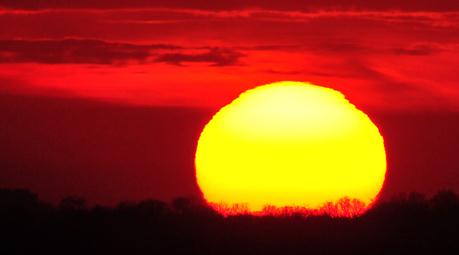
Blocking the Sun is No Plan B for Global Warming. Here’s a clip from Scientific American: “…As Kintisch puts it in his book, however, solar radiation management at this point is “not applied engineering” but “applied conceit.” The National Research Council in Washington, D.C., agreed with that view in its 2015 analysis of geoengineering, given that engineering implies a precision in expected outcome—a level of understanding that is unwarranted in this case, thus far. And geoengineering could have unintended consequences worse than climate change itself or end up exacerbating the underlying problem of too much CO2 by mistakenly taking the pressure off to reduce fossil fuel burning. There is also a fundamental question that remains unanswered: Because any action to fix the climate will affect the whole planet, who will have the authority to unleash actual geoengineering programs?…”

Did the Governator Just Come Up With a Republican-Proof Argument on Climate Change? ThinkProgress follows up; here’s a clip: “…And no matter what you think about clean energy, it is hard to argue against the unassailable point that fossil fuels are a limited resource that will eventually run out, offering a powerful economic argument for clean energy investment. “I, personally, want a plan,” he writes. “I don’t want to be like the last horse and buggy salesman who was holding out as cars took over the roads. I don’t want to be the last investor in Blockbuster as Netflix emerged. That’s exactly what is going to happen to fossil fuels.” Schwarzenegger has been outspoken on climate change for some time and is in Paris for the United Nations’ ongoing climate talks. He told BBC news this week that people should go vegetarian at least part-time in order to help mitigate their emissions...”
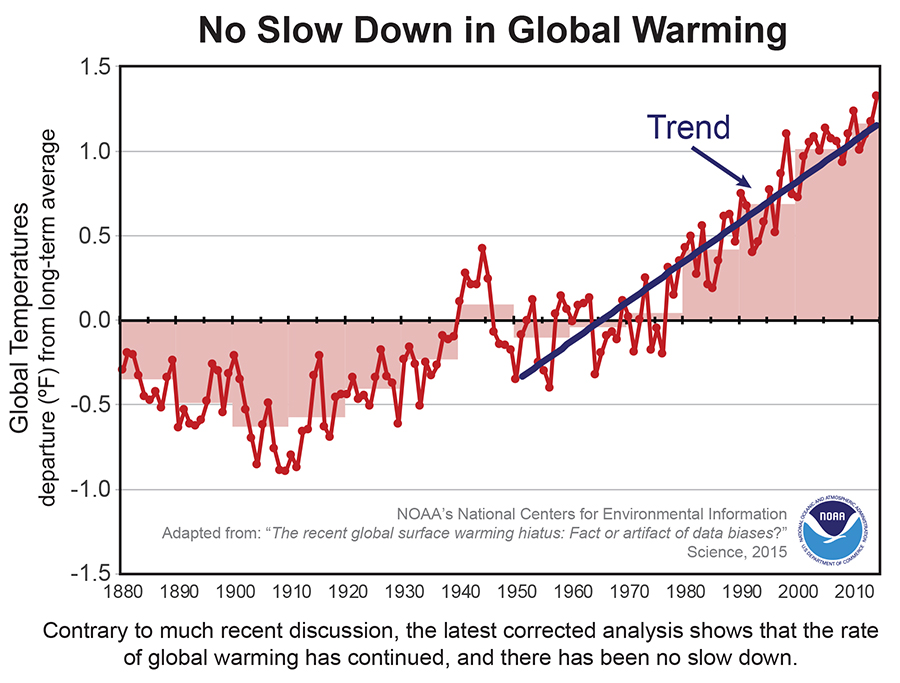
Everything Senator Ted Cruz Said About Climate Change in this NPR Interview was Wrong. So says Peter Gleick; here’s an excerpt of a recent post: “On December 9th, National Public Radio broadcast an interview between NPR’s Steve Inskeep and Senator Ted Cruz on the subject of climate change. Below is an annotated transcript of that interview with my [bracketed] responses to the consistently false scientific claims made by Senator Cruz. Effectively, every single scientific point he made was wrong – a classic “Gish Gallop” of long-debunked talking points of those who dispute the unambiguous scientific evidence of climate change. In these bracketed annotations I have provided a few hyperlinks to each of the myths he repeats. I have tried not to address the many other political and ideological points he made about climate change and scientists during this interview, though a few seem to have snuck in…”
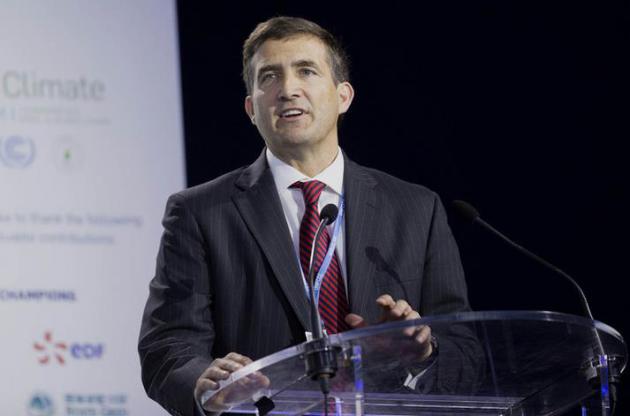
Photo credit above: “John Bryant, chief executive officer of Kellog Co., speaks during the caring for the climate summit at the United Nations COP21 climate summit, at Le Bourget, in Paris.” Photographer: Christophe Morin/Bloomberg.

The Real Climate-Change Villain Isn’t China. It’s Congress. The Daily Beast explains; here’s a link and excerpt: “…And the biggest threat to the climate in the medium term may not be China, the world’s biggest producer of greenhouses at the moment, where a dictatorial regime is pushing policies that will make dramatic differences; the problem is in the second-biggest producer of greenhouse gases, the United States, where Congress simply denies reality. “Congress is unwilling to do anything at this point,” said Ralph Becker, the mayor of Salt Lake City, Utah…”
Photo credit above: Damir Sagolj/Reuters.
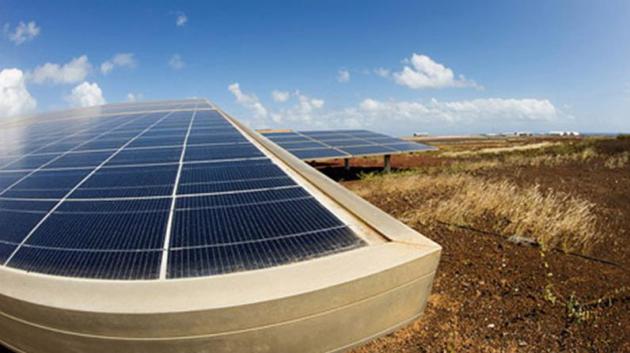
Solar: The Biggest Winner from Paris Climate Talks? Here’s a clip from Climate Home: “…Barclays Capital also found losers, where the fossil fuel industry would lose around $34 trillion in revenues cumulatively from 2014-2040 as a result of the new, national climate action pledges. Regarding winners from a low-carbon transition more generally, Goldman Sachs last week highlighted four “front runner” technologies: LED light bulbs; solar power; wind; and electric and hybrid vehicles. Along similar lines, two weeks ago, Bank of America Merrill Lynch highlighted nine “entry points” for investors: energy efficiency; wind; solar; renewable energy yieldcos; nextgen vehicles batteries and storage; nuclear; hydropower; diversified cleantech; and other cleantech...”
Photo credit: Lance Cheung/Flickr.
